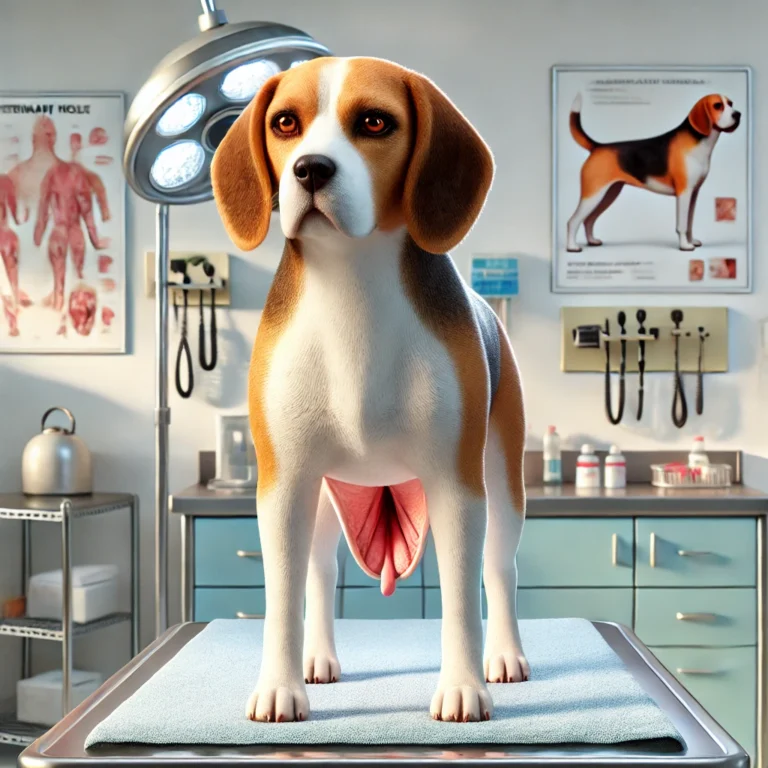pyometra in dogs

Pyometra in dogs is a severe and potentially life-threatening condition that affects the uterus. It is one of the most common reproductive health problems in unspayed female dogs, particularly in older ones. This article will provide a comprehensive understanding of pyometra in dogs, its symptoms, causes, treatment options, and prevention measures. By the end, you will have all the information you need to protect your pet from this dangerous condition.
What is Pyometra in Dogs?
Pyometra in dogs refers to a serious uterine infection caused by bacteria that results in pus accumulation inside the uterus. The infection can be life-threatening if left untreated. It is commonly observed in unspayed female dogs, particularly those over six years old, but can also affect younger dogs that have gone through multiple estrus cycles. Understanding the symptoms and early detection of pyometra can significantly improve the chances of recovery.

Types of Pyometra in Dogs
There are two main types of pyometra in dogs: open pyometra and closed pyometra.
- Open Pyometra in Dogs: In this form, the cervix is open, allowing the pus to drain out of the uterus. Although the discharge might seem like it provides relief, the dog still faces significant health risks, such as sepsis or further internal complications.
- Closed Pyometra in Dogs: In closed pyometra, the cervix remains closed, preventing the pus from draining. This can cause severe abdominal swelling, high risk of uterine rupture, and peritonitis. It is a more dangerous form of pyometra, often requiring immediate surgical intervention.
What Causes Pyometra in Dogs?
Understanding the underlying causes of pyometra can help prevent this life-threatening condition. The primary cause of pyometra in dogs is hormonal imbalance, but several factors contribute to the disease’s development.
Hormonal Changes and Pyometra in Dogs
In unspayed female dogs, hormonal changes associated with the estrus cycle (heat cycle) can lead to cystic endometrial hyperplasia (CEH), a condition where the lining of the uterus thickens and forms cysts. This makes the uterus more susceptible to bacterial infections, resulting in pyometra.
Bacterial Infections and Pyometra in Dogs
Bacterial infections, typically stemming from the vaginal area, enter the uterus, causing the infection. This infection leads to the accumulation of pus and other dangerous complications.
Age and Spaying Status: A Risk Factor for Pyometra in Dogs
Older, unspayed female dogs are at the highest risk of developing pyometra. The longer a dog goes without being spayed, the higher the chances of her developing this condition.
Previous Heat Cycles: How Pyometra in Dogs Develops
Dogs that have gone through multiple heat cycles without being spayed have an increased risk of developing canine pyometra. The hormonal changes associated with estrus may cause the uterine lining to become more vulnerable to infections.
What Are the Symptoms of Pyometra in Dogs?
Recognizing the symptoms of pyometra in dogs is crucial for early intervention. These symptoms may vary depending on whether the dog has open or closed pyometra. However, there are some common signs that owners should be aware of.
Early Signs of Pyometra in Dogs
- Lethargy and Depression: Dogs suffering from pyometra often show signs of lethargy or a noticeable decrease in activity levels. This is one of the first signs of pyometra.
- Loss of Appetite: Affected dogs may stop eating or drinking due to the discomfort and infection.
- Vomiting and Diarrhea: In some cases, pyometra dogs may experience vomiting and diarrhea as the infection spreads.
- Increased Thirst and Urination: Dogs with pyometra often drink and urinate more frequently.
Signs of Pyometra in Dogs: Open vs. Closed
- Open Pyometra in Dogs:
- Vaginal Discharge: One of the most noticeable symptoms is the presence of thick, foul-smelling pus or blood-tinged discharge from the vagina.
- Mild Abdominal Distension: The belly may feel slightly swollen but not as severely as with closed pyometra.
- Closed Pyometra in Dogs:
- Severe Abdominal Swelling: The uterus becomes distended with pus, causing the abdomen to enlarge.
- Painful Abdomen: Your dog may exhibit discomfort when you touch or press her abdomen.
- Signs of Shock: If the infection becomes severe, symptoms such as rapid breathing, increased heart rate, and even collapse can occur.
Do you know?
Left untreated, pyometra in cats can turn deadly in just days—learn how to spot the signs of pyometra in cats before it’s too late
Pictures of Pyometra in Dogs
It can be helpful for dog owners to recognize the pictures of pyometra. While the vaginal discharge in open pyometra is a visual cue, ultrasound imaging is often used by vets to confirm the presence of pyometra in dogs and assess the severity of the condition.
How is Pyometra in Dogs Diagnosed?
Diagnosis of pyometra in dogs typically involves a combination of physical exams, laboratory tests, and imaging techniques. Here’s how your vet might approach the diagnosis:
1. Physical Examination for Pyometra in Dogs
The vet will check for signs such as abdominal tenderness, fever, and the presence of vaginal discharge. These can provide initial clues that the dog might be suffering from pyometra in dogs.
2. Blood Tests for Pyometra in Dogs
Blood tests are crucial in confirming the infection. Elevated white blood cell counts and signs of liver or kidney dysfunction are often observed in pyometra dogs. Blood work also helps determine if there are any additional complications.
3. Ultrasound or X-rays for Pyometra in Dogs
To confirm the diagnosis of pyometra in dogs, the vet may use ultrasound imaging to examine the uterus. This allows them to visualize the fluid-filled uterus and determine if the dog is suffering from open or closed pyometra. Pyometra ultrasound dog is a non-invasive way to assess the severity of the infection and guide treatment decisions.
Treatment for Pyometra in Dogs
The treatment for pyometra in dogs typically depends on the severity of the condition and whether the dog is spayed or not. There are two primary treatment options: surgery and medical management.
1. Pyometra Surgery: Ovariohysterectomy
The most common and effective treatment for pyometra in dogs is an ovariohysterectomy, which involves the removal of the uterus and ovaries. This surgical procedure eliminates the infection and prevents future occurrences of pyometra in dogs.
- Pyometra Surgery Recovery: After surgery, your dog will need to be monitored closely for any signs of complications, such as infection or bleeding. Most dogs recover well after surgery, though the recovery process may take several weeks.
- Pyometra Dog Surgery Cost: The cost of pyometra dog surgery can vary depending on the clinic and the dog’s size, but it generally ranges from $500 to $2,000.
2. Medical Management of Pyometra in Dogs
In some cases, especially when surgery is not an option due to age or other health factors, pyometra in dogs treatment may involve medication. Prostaglandins are used to induce uterine contractions to expel the pus from the uterus. However, medical treatment is less effective than surgery and carries a risk of recurrence.
3. Supportive Care for Pyometra in Dogs
Whether treated surgically or medically, dogs with pyometra in dogs often require supportive care. This may include:
- IV Fluids for dehydration
- Pain Management
- Antibiotics to treat secondary bacterial infections
What is the Prognosis for Dogs with Pyometra?
The prognosis for pyometra in dogs depends largely on how quickly the disease is diagnosed and treated. If treated promptly with surgery, the survival rate is generally very high. However, if left untreated or if there is a delay in seeking treatment, pyometra can be fatal.
- Surgical Treatment Prognosis: If a dog undergoes pyometra surgery promptly, the prognosis is excellent, with most dogs making a full recovery.
- Medical Management Prognosis: While some dogs can recover with medical treatment, there is a higher risk of complications such as uterine rupture or septic shock. Medical management also has a higher chance of recurrence.
How to Prevent Pyometra in Dogs
The best way to prevent pyometra in dogs is by spaying. Spaying your dog before her first heat cycle significantly reduces the risk of developing pyometra in dogs and other reproductive health issues. Here’s how you can protect your dog:
1. Spaying Your Dog to Prevent Pyometra in Dogs
Spaying involves the removal of the ovaries and uterus, which not only prevents pyometra in dogs but also eliminates the possibility of ovarian and uterine cancer.
2. Regular Veterinary Check-ups to Monitor Pyometra in Dogs
For unspayed dogs, regular veterinary check-ups are essential for early detection of pyometra in dogs. Your vet can monitor your dog’s health and recommend timely intervention if any issues arise.
Conclusion: Protecting Your Dog from Pyometra
Pyometra in dogs is a serious condition, but with early detection and prompt treatment, many dogs make full recoveries. If you notice any signs of pyometra in dogs, such as abnormal discharge or changes in behavior, seek veterinary care immediately. Spaying your dog is the most effective way to prevent this disease and ensure her long-term health.
By understanding the symptoms, causes, and treatment options for pyometra in dogs, you can act quickly and help safeguard your dog from this life-threatening condition.
What is the main cause of pyometra?
The primary cause of pyometra is a bacterial infection in the uterus, which occurs due to hormonal imbalances during the estrus (heat) cycle. The hormones estrogen and progesterone play a role in altering the uterine lining, making it more susceptible to bacterial infection, leading to pus accumulation. This is most common in unspayed female dogs and cats that have not been neutered.
What is pyometra in dogs and cats?
Pyometra is a life-threatening uterine infection that occurs in female dogs and cats, particularly those that are unspayed. It involves bacterial infection of the uterus, leading to pus accumulation. It can manifest as an open or closed form, depending on whether the cervix remains open or closed. The condition requires urgent veterinary care, typically through surgery (spaying) or medication, and is more common in older animals that have not been spayed.
What breeds of dogs get pyometra?
Pyometra can occur in any breed of dog, but it is more common in older, unspayed females, particularly those that have had multiple heat cycles. Breeds that are more prone include large-breed dogs like the Golden Retriever, German Shepherd, and Dachshund. However, it can affect all breeds, with the risk increasing with age and lack of spaying.
What is the pathogenesis of pyometra?
The pathogenesis of pyometra begins with hormonal changes during the estrus cycle. High levels of progesterone stimulate changes in the uterine lining, causing cystic endometrial hyperplasia (CEH), which makes the uterus more vulnerable to infection. Bacteria, typically from the vaginal area, invade the uterus and cause an infection. In open pyometra, the cervix is open, allowing the pus to drain. In closed pyometra, the cervix remains closed, trapping the pus inside, leading to a more severe form of the disease.
What hormone is responsible for pyometra?
Progesterone is the hormone primarily responsible for the development of pyometra. After a dog’s estrus cycle (heat), progesterone levels remain elevated, causing changes in the uterus that promote bacterial growth. This hormone helps prepare the uterus for pregnancy, but in the absence of pregnancy, it increases the risk of pyometra by creating a favorable environment for bacterial infections.
How do you diagnose pyometra in dogs?
Pyometra is typically diagnosed through a combination of:
Physical examination (looking for signs like abdominal swelling, fever, or vaginal discharge).
Blood tests, which may show elevated white blood cell counts and signs of infection.
Ultrasound or X-rays, which help visualize the uterus and confirm the presence of fluid or pus inside the uterus. A definitive diagnosis is based on these findings, along with clinical symptoms.
What are the first signs of pyometra?
The first signs of pyometra in dogs often include:
Lethargy or lack of energy.
Loss of appetite.
Increased thirst (polydipsia) and urination (polyuria).
Vaginal discharge (in open pyometra), which is often thick and foul-smelling.
Abdominal tenderness or swelling (especially in closed pyometra).
If you notice any of these symptoms, immediate veterinary care is necessary.
What is the preferred treatment for pyometra in dogs?
The preferred treatment for pyometra in dogs is surgical removal of the uterus and ovaries (spaying). This procedure, called ovariohysterectomy, is the most effective way to treat pyometra and prevent future occurrences. In some cases, if surgery is not an option (for example, in older or high-risk dogs), medical management with antibiotics and prostaglandin injections may be attempted, but it carries a higher risk of recurrence.
What is the first stage of pyometra?
The first stage of pyometra is characterized by hormonal changes during the heat cycle, leading to cystic endometrial hyperplasia (CEH). This thickening of the uterine lining creates a conducive environment for bacterial growth. In this early phase, there may be no obvious symptoms, but the uterine lining becomes more vulnerable to infection, setting the stage for the development of pyometra once bacteria invade the uterus. This stage progresses rapidly without intervention, leading to the formation of pus and other clinical signs.






